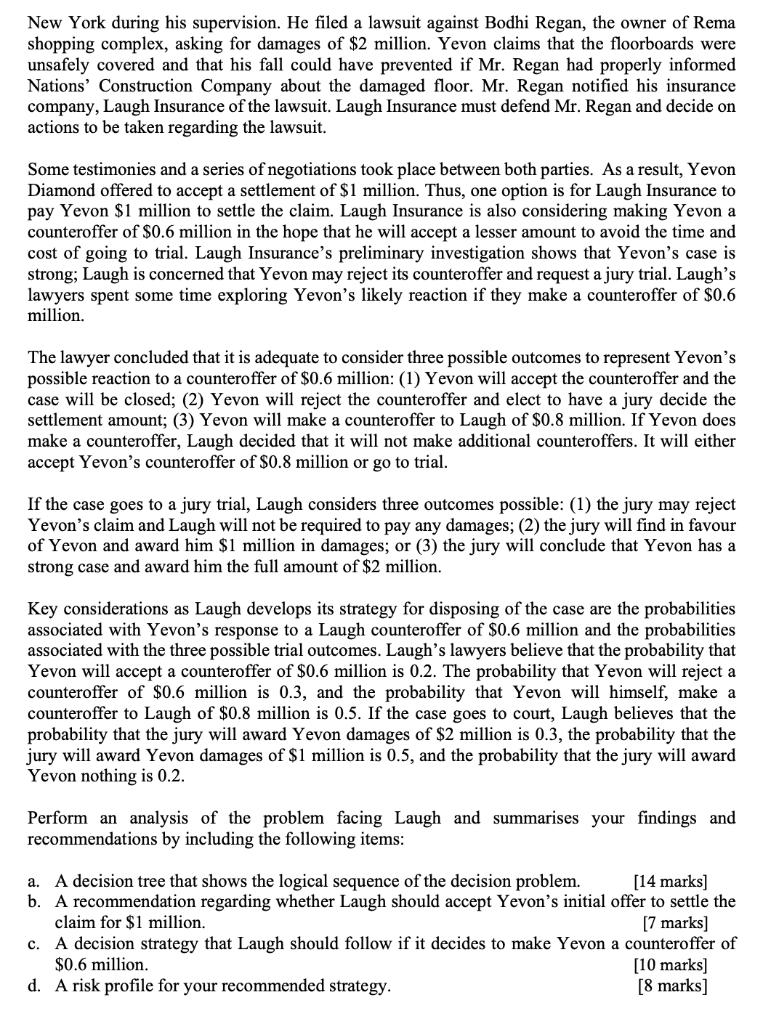Answered step by step
Verified Expert Solution
Question
1 Approved Answer
Yevon Diamond, an engineer of Nations' Construction Company, claims to have injured his back by slipping off on the covered but damaged floorboards at


Yevon Diamond, an engineer of Nations' Construction Company, claims to have injured his back by slipping off on the covered but damaged floorboards at Rema shopping complex building in New York during his supervision. He filed a lawsuit against Bodhi Regan, the owner of Rema shopping complex, asking for damages of $2 million. Yevon claims that the floorboards were unsafely covered and that his fall could have prevented if Mr. Regan had properly informed Nations' Construction Company about the damaged floor. Mr. Regan notified his insurance company, Laugh Insurance of the lawsuit. Laugh Insurance must defend Mr. Regan and decide on actions to be taken regarding the lawsuit. Some testimonies and a series of negotiations took place between both parties. As a result, Yevon Diamond offered to accept a settlement of $1 million. Thus, one option is for Laugh Insurance to pay Yevon $1 million to settle the claim. Laugh Insurance is also considering making Yevon a counteroffer of $0.6 million in the hope that he will accept a lesser amount to avoid the time and cost of going to trial. Laugh Insurance's preliminary investigation shows that Yevon's case is strong; Laugh is concerned that Yevon may reject its counteroffer and request a jury trial. Laugh's lawyers spent some time exploring Yevon's likely reaction if they make a counteroffer of $0.6 million. The lawyer concluded that it is adequate to consider three possible outcomes to represent Yevon's possible reaction to a counteroffer of $0.6 million: (1) Yevon will accept the counteroffer and the case will be closed; (2) Yevon will reject the counteroffer and elect to have a jury decide the settlement amount; (3) Yevon will make a counteroffer to Laugh of $0.8 million. If Yevon does make a counteroffer, Laugh decided that it will not make additional counteroffers. It will either accept Yevon's counteroffer of $0.8 million or go to trial. If the case goes to a jury trial, Laugh considers three outcomes possible: (1) the jury may reject Yevon's claim and Laugh will not be required to pay any damages; (2) the jury will find in favour of Yevon and award him $1 million in damages; or (3) the jury will conclude that Yevon has a strong case and award him the full amount of $2 million. Key considerations as Laugh develops its strategy for disposing of the case are the probabilities associated with Yevon's response to a Laugh counteroffer of $0.6 million and the probabilities associated with the three possible trial outcomes. Laugh's lawyers believe that the probability that Yevon will accept a counteroffer of $0.6 million is 0.2. The probability that Yevon will reject a counteroffer of $0.6 million is 0.3, and the probability that Yevon will himself, make a counteroffer to Laugh of $0.8 million is 0.5. If the case goes to court, Laugh believes that the probability that the jury will award Yevon damages of $2 million is 0.3, the probability that the jury will award Yevon damages of $1 million is 0.5, and the probability that the jury will award Yevon nothing is 0.2. Perform an analysis of the problem facing Laugh and summarises your findings and recommendations by including the following items: a. A decision tree that shows the logical sequence of the decision problem. b. A recommendation regarding whether Laugh should accept Yevon's initial offer to settle the claim for $1 million. c. A decision strategy that Laugh should follow if it decides to make Yevon a counteroffer of $0.6 million. d. A risk profile for your recommended strategy. [14 marks] [7 marks] [10 marks] [8 marks]
Step by Step Solution
★★★★★
3.44 Rating (160 Votes )
There are 3 Steps involved in it
Step: 1
A A decision tree describes the condition associated with the particular action or decision The decision tree can show you the function in other words ...
Get Instant Access to Expert-Tailored Solutions
See step-by-step solutions with expert insights and AI powered tools for academic success
Step: 2

Step: 3

Ace Your Homework with AI
Get the answers you need in no time with our AI-driven, step-by-step assistance
Get Started


